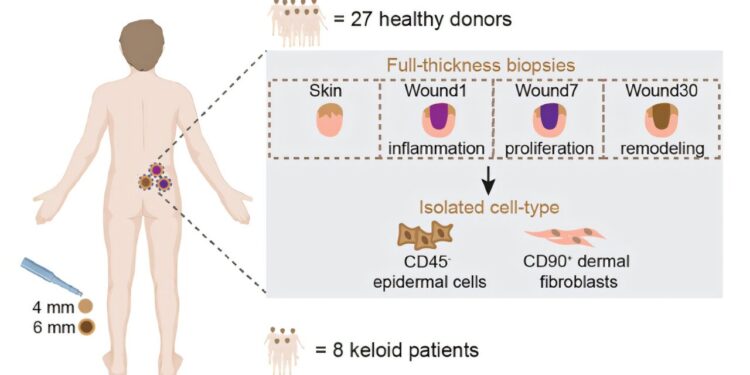Excisive injuries were created on the skin of 27 healthy volunteers and collected 1 (Wound1), 7 (Wound7) and 30 days later (Wound30) of the same donor. Credit: Advanced science (2025). DOI: 10.1002 / ADVS.202416784
Researchers from the Karolinska Institute have identified a new mechanism where circular RNA plays a crucial role in wound healing, which could lead to new therapies to improve the healing of wounds and reduce scars. The study is published in Advanced science.
A new study shows how circular RNA (Circrna) affects the healing of wounds in human skin. The researchers discovered a single circus, Cirglis3 (2), which temporarily increases in skin cells, called fibroblasts, after an injury. Cirglis3 (2) is activated by current injury signals such as inflammation, low oxygen levels and cellular stress.
“What makes Cirglis3 (2) special is his double role in the healing of the wounds,” explains Guanglin Niu, a postdoctoral researcher in the Department of Medicine. “Its RNA stabilizes the Cytoplasmic Protein Pcolce and activates fibroblasts to reconstruct damaged tissues, while its protein binds to BTF3 in the cell nucleus and promotes cell growth.”
Versatile RNA with double function
The study shows that Cirglis3 (2) works both as a regulatory RNA and as a molecule coding for proteins. This double function is expanding our understanding of the versatility of non -coding RNAs in the control of complex cellular behavior, such as the activation and proliferation of fibroblasts in response to injury. Biologically, he emphasizes how cells use a single transcription to adapt to dynamic environmental changes.
To conduct the study, the researchers developed a unique model for the healing of human wounds and collected excision wounds full of thickness of healthy volunteers at several calendar points.
The sequencing of the RNA of wounds healing and isolated skin revealed the Circrna expressed differently, Cirglis3 (2) showing increased levels in fibroblasts and biopsies of the wounds. The sequence analysis has identified an open reading frame (ORF) in Cirglis3 (2), leading to a more in -depth study of its protein coding potential.
“Our results discover a new regulatory mechanism in wound healing,” explains Maria A. Toma, Co-Nul and former doctorate. Student of the Ning Xu Landén research group.
Ning Xu Landén, associate professor of the same department, adds: “The double function of Cirglis3 (2) makes it a promising therapeutic target, in particular to improve the results of fibrotic or difficult to cure injuries.”
Additional research is necessary to explore the wider implications of RNA with double coding and non -coding functions. A more in -depth overview of this phenomenon can reveal new aspects of gene regulation, cell adaptability and potential therapeutic opportunities.
More information:
Guanglin Niu et al, collaborative duality of the Cirglis3 (2) RNA and proteins in the repair of human wounds, Advanced science (2025). DOI: 10.1002 / ADVS.202416784
Quote: Scientists discover how the circular RNA affects wound healing (2025, April 29) recovered on April 29, 2025
This document is subject to copyright. In addition to any fair program for private or research purposes, no part can be reproduced without written authorization. The content is provided only for information purposes.



